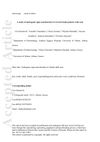
Search
forProducts matching "acne rosacea"
Tracking 1 products like 237 Cystiphane Loción Anticaida 125 Ml (Biorga) from by companies like Farmacia Tristaina / Andorra. View product »
Sort by
Research
870-900 / 1000+ results

research Update and Future of Hormonal Therapy in Acne
Hormonal therapy is becoming a promising treatment for acne.
research Immunolocalization of 5α-Reductase Isozymes in Acne Lesions and Normal Skin
The study found that the enzyme linked to acne is present in the same areas of both acne-affected and normal skin.

research Antiandrogen And Hormonal Treatment Of Acne
Certain hormone treatments can improve acne and related conditions in women.

research Androgenic Hormone Profile of Adult Women with Acne
Over half of the adult women with acne in the study had higher than normal levels of male hormones, especially DHEA.

research Oral Contraceptives and Cyproterone Acetate in Female Acne Treatment
Birth control pills and cyproterone acetate can help treat acne in women, especially when linked to hormonal issues.
research RU 58841-Myristate Prodrug Development for Topical Treatment of Acne and Androgenetic Alopecia
RUM-loaded SLN shows promise for treating acne and hair loss topically.

research Treatment of Androgenic Disorders in Women: Acne, Hirsutism, and Alopecia
Androgen excess disorders in women were effectively treated with spironolactone, estrogen, and dexamethasone.

research Selective Induction of Apoptosis in the Hamster Flank Sebaceous Gland Organ by a Topical Liposome 5-Alpha-Reductase Inhibitor: A Treatment Strategy for Acne
A topical treatment safely and effectively reduced acne by causing targeted cell death in sebaceous glands without side effects.

research Guidelines of Care for the Management of Acne Vulgaris
Use benzoyl peroxide, retinoids, antibiotics, and isotretinoin for acne, and combine treatments for better results.
research Cutaneous Hyperandrogenism: Role of Antiandrogen Therapy in Acne, Hirsutism, and Androgenetic Alopecia

research A Study of Androgenic Signs and Disorders in Greek Female Patients with Acne
Almost 40% of Greek women with acne show signs of androgen-related disorders, with adult women more likely affected.
research Efficacy of 0.1% Adapalene in a Non-Inflammatory Kyoto Rhino Rat Acne Model
Adapalene 0.1% effectively reduces acne by decreasing comedones and altering skin properties.

research Spironolactone in Dermatology: Uses in Acne, Hidradenitis Suppurativa, Female Pattern Hair Loss, and Hirsutism
research Evidence-Based Clinical Guidelines for Treatment: Acne and Androgenetic Alopecia
research The Potential Role of Acetylcholine Receptors in Acne Inversa Pathogenesis
Acetylcholine receptors might be involved in the development of acne inversa and smoking could worsen the condition.

research Traditional and Alternative Methods of Acne Treatment
Spironolactone and clascoterone are promising acne treatments with fewer side effects.

research Potential of Delonix Polymeric Nanoparticles Containing Isotretinoin for Acne Treatment
Delonix polymeric nanoparticles with isotretinoin effectively treat acne by targeting hair follicles and reducing skin irritation.

research Homeostasis of the Sebaceous Gland and Mechanisms of Acne Pathogenesis
The document's conclusion cannot be provided because the document is not available to parse.

research Genome-Wide Meta-Analysis Implicates Mediators of Hair Follicle Development and Morphogenesis in Risk for Severe Acne
Genetic variations affecting skin structure play a key role in severe acne.
research Thymol-Loaded PLGA Nanoparticles: An Efficient Approach for Acne Treatment
Thymol-loaded nanoparticles are a promising, natural treatment for acne that avoids antibiotics and preserves healthy skin bacteria.

research Endocrinological Evaluation and Hormonal Therapy for Women with Difficult Acne
Hormonal therapy is a good option for women with severe acne, especially when there's a chance of hormone imbalance.

research Irregular Menstruation, Acne, Hirsutism, and the Possibility of PCOS
Women with irregular periods should be checked for PCOS and treated early to prevent complications, with birth control pills helping to manage symptoms.

research A Comparison of the Conceptual Understanding and Management of Acne Vulgaris Amongst Registered Homeopaths and Izinyanga in KwaZulu-Natal
Homoeopaths and traditional healers in KwaZulu-Natal have different understandings and ways of treating acne.

research The Development of BRL 7660 as an Anti-Acne Agent
BRL 7660, once studied for male contraception, showed promise as an acne treatment but was not developed further due to competing drugs.

research ADT-G as a Promising Biomarker for Peripheral Hyperandrogenism in Adult Female Acne
ADT-G may be a useful indicator of increased androgen levels in women with acne and can be lowered with certain birth control pills.